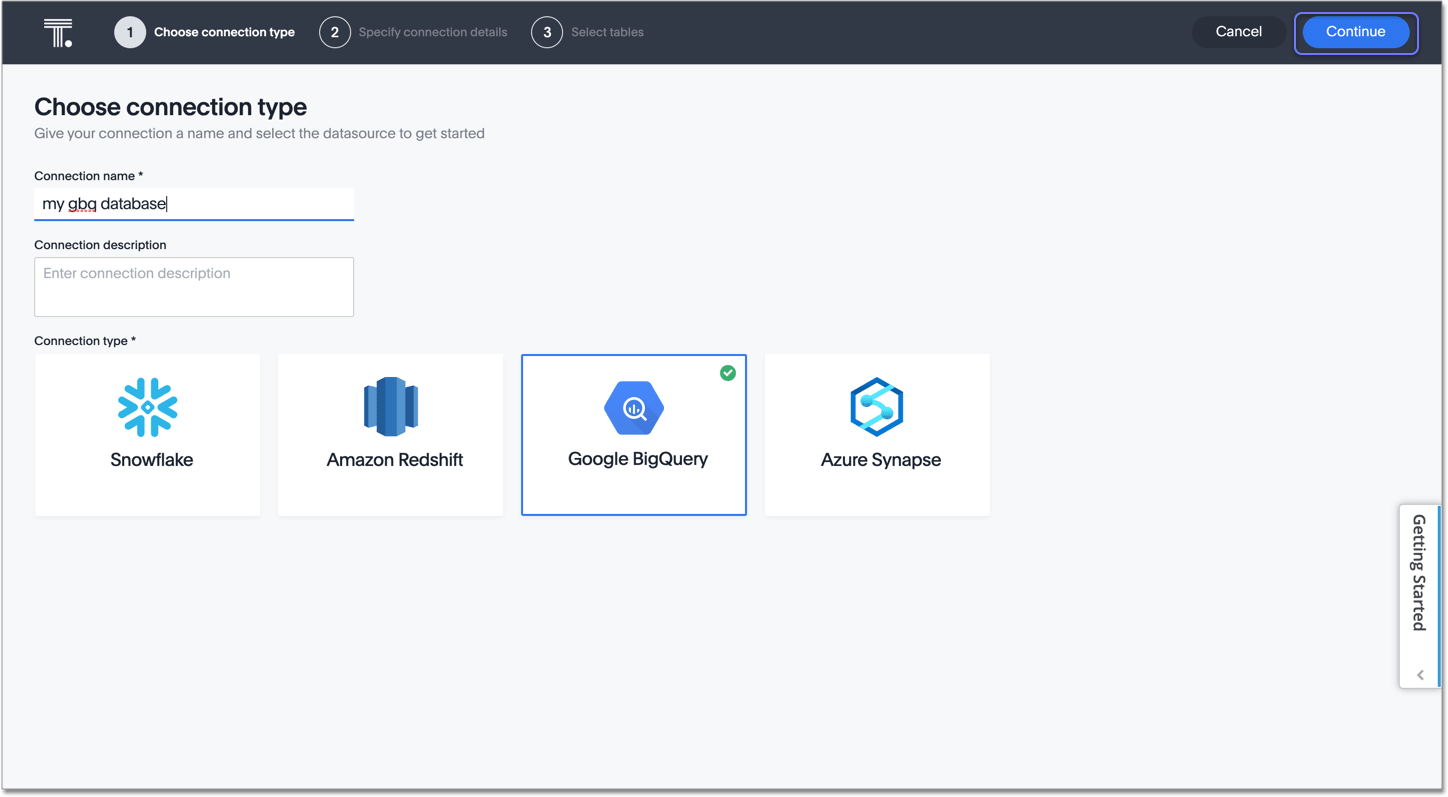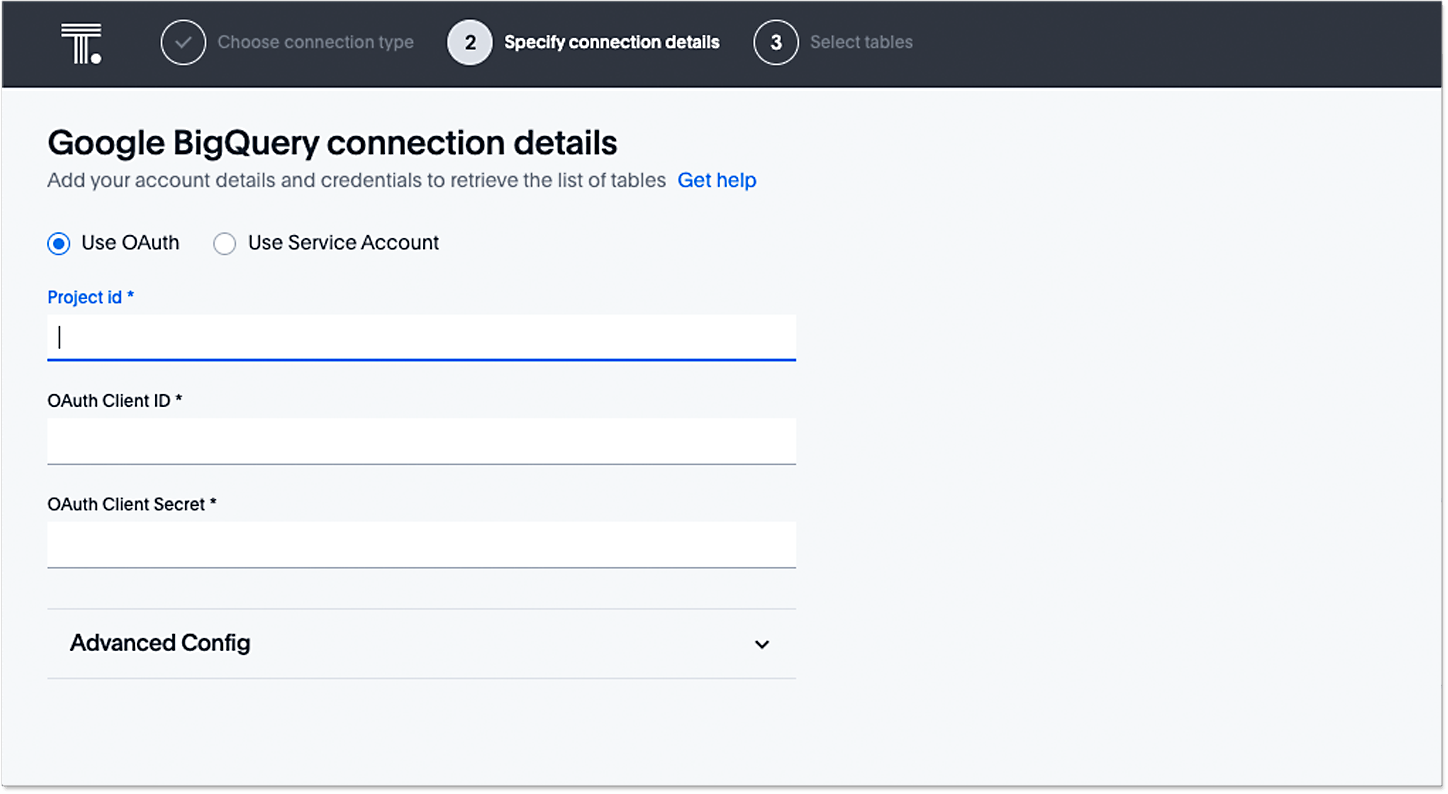Add a Google BigQuery connection
Before you can create a connection, you must create a custom role. For more information, see Prerequisites.
To connect to Google BigQuery:
-
Navigate to Data workspace > Connections.
-
Click + Create connection, and select the Google BigQuery tile. Then click Next.
-
Create a name for your connection, a description (optional), and enter the connection details for your Google BigQuery data source. Then click Next.

For OAuth authentication, do the following:
-
Enter Billing Project id, Additional Projects (optional), OAuth Client ID, and OAuth Client Secret.

-
If you wish to provide the optional additional key-value pairs for your Google BigQuery connection, complete the procedure in step 5, and then select Continue. If not, select Continue.
-
At the Google account sign-in screen, select your Google account.
-
Allow thoughtspot.com access to your Google account by selecting Allow, and then go to step 7 to select tables for your connection.
Using security passthrough may have implications for your Row-Level Security. See About row-level security (RLS) for more information.
For service account authentication, do the following:
-
Enter Billing Project id, Additional Projects (optional), and Service account.

Refer to the Google BigQuery connection reference for more information on each of the specific attributes you must enter for your connection.
-
(Optional) Provide additional key-value pairs that you need to set up your connection to Google BigQuery or customize additional JDBC parameters supported by Google BigQuery, by doing the following:
-
-
-
Select the Advanced Config menu to reveal the Key and Value fields.
-
Enter your key and value information. Refer to the GBQ JDBC documentation.
-
To add more keys and values, select the plus sign (+), and enter them.
Any key-value pairs that you enter must be defined in your Google BigQuery data source. Key-value pairs are case-sensitive. -
If you are connecting to GBQ using a Bridge connector, enter the following key-value pair under Advanced Config.
-
For Key, enter
bridgeToken. -
For Value, enter your bridge token value.
-
The Bridge connector for Google BigQuery is off by default. To enable this feature, contact ThoughtSpot support. ThoughtSpot Support will provide you with the bridge token, token secret, and "host:port" of the bridge public load balancer for your cluster. To use the Bridge connector for Google BigQuery, you must run a Bridge Client on a network connected to your Google BigQuery database. -
Select Continue.
-
Select tables and the columns from each table, and then click Validate and save.
-
A message appears indicating the number of tables and columns that will be added to your connection.
Once the connection is added, you can search your BiqQuery database right away by selecting Search now.
Your new connection appears on the Data workspace > Connections page. Select the name of your connection to view the tables and columns in your connection.
The connection you just created is a link to the external data source. If there are any joins in the selected tables of the external data source, those are imported into ThoughtSpot. We also import column and table descriptions, if they exist.
You can now perform a live query on the selected tables and columns of your connection. Because the selected tables and columns in your connection are linked, it may take a while to initially render the search results. This is because ThoughtSpot does not cache linked data. With linked data, ThoughtSpot queries the external database directly, which is slower than querying data that is stored in ThoughtSpot’s database.
You can modify a Google BigQuery connection in the following ways:
You can also Delete a Google BigQuery connection.
See the Connection reference for details of connection parameters.
Share a connection
Users with can manage data or admin privileges can share connections with other users or groups that have can manage data privileges. Once granted access to a connection, users can add, remove, and modify tables in that connection.
To share a connection with another user, follow these steps:
-
Navigate to the Data workspace > Connections.
-
Select the checkbox next to the name of the connection you want to share, and click Share.
-
In the Share connection dialog, enter the ID of the user or group you want to share the connection with. You can use the search bar to find the user or group.
-
Select Done.
Note that to remove share access from a connection, you must navigate to the Share connection dialog and select Remove access to the left of the user group or name.
Create an additional configuration for your Google BigQuery connection
To create an additional configuration for your Google BigQuery connection, do the following:
-
Navigate to the Data workspace > Connections.
-
In the list of connections, find the connection where you want to add a configuration.
-
At the far right of your connection, click the More menu
 , and select Create configuration.
, and select Create configuration.
-
In the Add configuration details window, specify the following:
-
Authentication type
-
For OAuth:
-
Billing Project id
-
Additional Projects (optional)
-
OAuth Client ID
-
OAuth Client Secret
-
Advanced Config (optional)
-
-
For Service Account:
-
Billing Project id
-
Additional Projects (optional)
-
Service Account
-
Advanced Config (optional)
-
-
-
Click Continue.
Depending on the authentication type, you may have to sign in to your Google BigQuery account.
-
(Optional) If the Google BigQuery sign-in screen appears, sign in to Google BigQuery. Then, when a message appears asking you to allow your connection access to your Google BigQuery account, click Allow.
The connection is validated by ThoughtSpot and then the Describe your configuration window appears.
-
Create a name and (optional) description of your configuration, and click Continue.
-
In the Select policy type window, select from the following options:
- No Policy
-
Choose this if you want to save the configuration, but not apply the policy to your connection yet.
- Users and groups
-
Choose this if you want to specify users and groups who can use the connection.
- Processes
-
Choose this if you want to use this configuration for search indexing and row count stats. Make sure Sage indexing and Row count stats are checked.
-
Click Continue.
Your additional configuration is complete and appears below your connection’s name on the Connections page.
Configurations that are greyed out are currently disabled.
You can edit additional configurations after you create them, including disabling and deleting them. For details, see Edit additional connections of your Google BigQuery connection.
Related information



